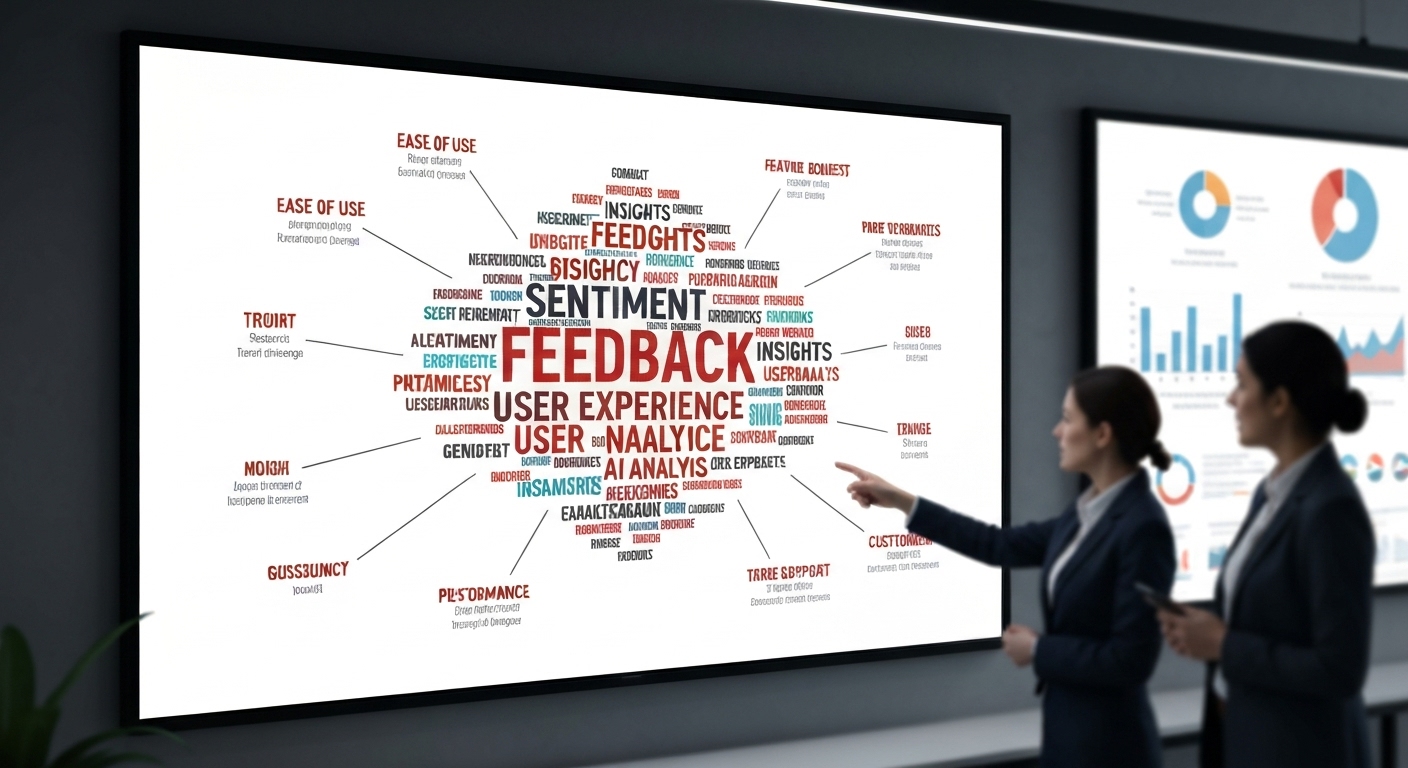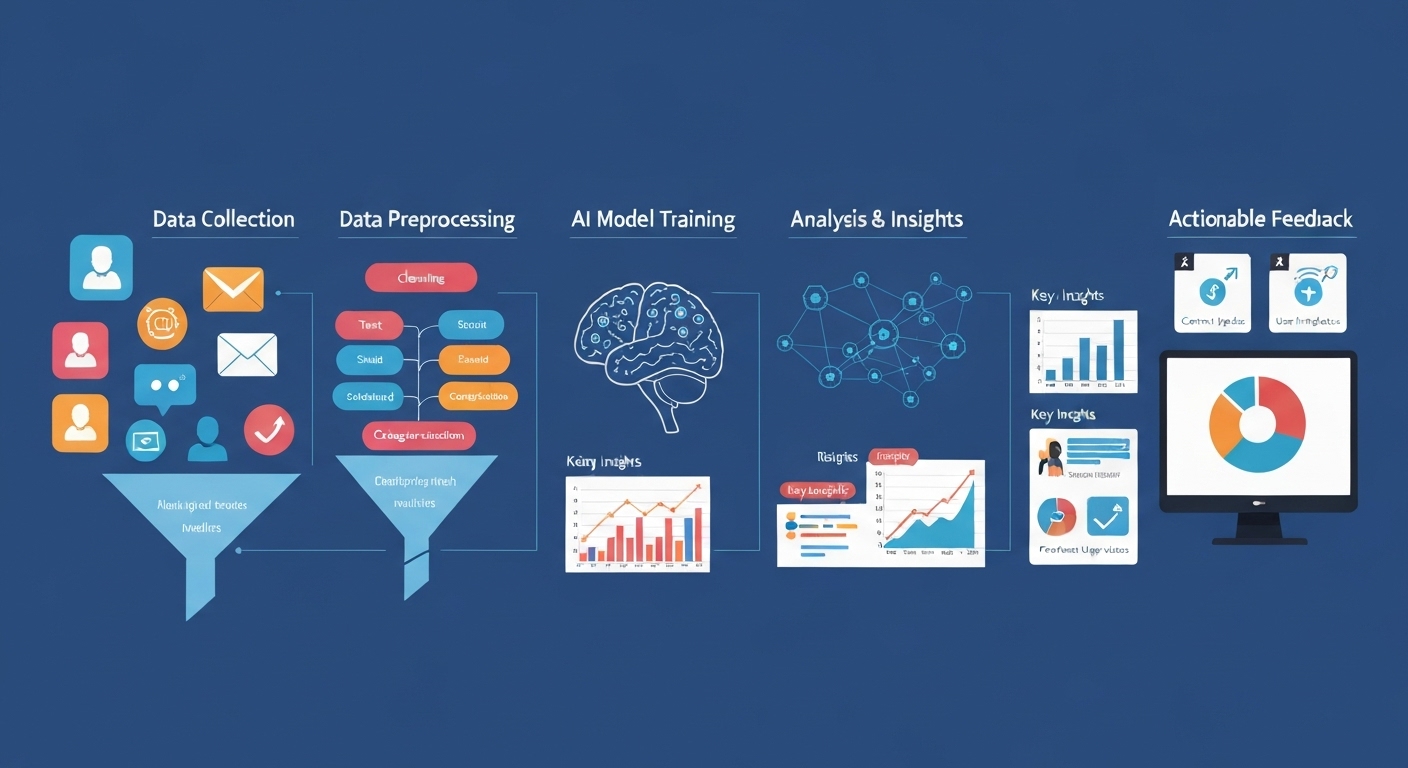How to Use AI to Analyze User Feedback : A Comprehensive Guide
How to use ai to analyze user feedback is a question many businesses are asking as they seek to understand their customers better. In today’s data-driven world, leveraging artificial intelligence (AI) to process and interpret user feedback can provide invaluable insights, leading to improved products, enhanced customer experiences, and increased customer satisfaction. This article will guide you through the process of using AI for user feedback analysis, covering key tools, techniques, and best practices.
Understanding the Power of AI in User Feedback Analysis
Traditional methods of analyzing user feedback, such as manual reviews and surveys, are often time-consuming and prone to human error. AI offers a more efficient and accurate alternative. AI-powered feedback analysis can automatically process large volumes of data from various sources, identify patterns, and extract meaningful insights. This allows businesses to gain a deeper understanding of customer sentiment and preferences at scale.

Key AI Techniques for Analyzing User Feedback
Several AI techniques are commonly used for user feedback analysis, each offering unique capabilities:
- Sentiment Analysis: Determines the emotional tone (positive, negative, neutral) expressed in the feedback.
- Text Analytics: Extracts key themes, topics, and entities from the text.
- Natural Language Processing (NLP): Enables machines to understand and process human language, facilitating tasks like topic modeling and keyword extraction.
- Machine Learning (ML): Uses algorithms to learn from data and make predictions or classifications, such as identifying customer churn risk based on feedback.
Sentiment Analysis: Gauging Customer Emotions
Sentiment analysis is a crucial component of AI-driven feedback analysis. It allows businesses to understand how customers feel about their products, services, or brand. By identifying the sentiment expressed in user feedback, companies can quickly address negative issues and capitalize on positive feedback. Tools like monkeylearn.com can automate sentiment analysis and provide actionable insights.
Text Analytics and Topic Modeling: Identifying Key Themes
Text analytics and topic modeling help uncover the underlying themes and topics within user feedback. This allows businesses to identify the most common issues, trends, and areas for improvement. By understanding the key topics discussed in feedback, companies can prioritize their efforts and allocate resources effectively. Implementing text analytics for feedback can transform unstructured data into actionable intelligence.

NLP for Enhanced Understanding
Natural Language Processing (NLP) plays a vital role in understanding the nuances of human language. NLP techniques can be used to identify sarcasm, irony, and other subtle cues that might be missed by simpler analysis methods. This leads to a more accurate and nuanced understanding of customer sentiment and preferences. NLP algorithms are particularly useful for analyzing complex and unstructured feedback data.
Choosing the Right AI Tools for User Feedback Analysis
Numerous AI tools are available for user feedback analysis, each with its own strengths and weaknesses. Some popular options include:
- MonkeyLearn: Offers a comprehensive suite of text analytics and sentiment analysis tools.
- Lexalytics: Provides advanced natural language processing capabilities.
- MeaningCloud: A cloud-based text analytics platform with a wide range of features.
- Google Cloud Natural Language API: A powerful NLP API from Google.
When choosing an AI tool, consider factors such as the volume of data you need to analyze, the complexity of your feedback data, and your budget. It’s also important to ensure that the tool integrates seamlessly with your existing systems and workflows.
Step-by-Step Guide: Implementing AI for User Feedback Analysis
Here’s a step-by-step guide to implementing AI for user feedback analysis:
- Define Your Goals: Clearly define what you want to achieve with user feedback analysis. Do you want to improve customer satisfaction, identify product defects, or understand market trends?
- Collect User Feedback: Gather feedback from various sources, such as surveys, reviews, social media, and support tickets.
- Prepare Your Data: Clean and preprocess your data to remove noise and inconsistencies.
- Choose an AI Tool: Select an AI tool that meets your needs and integrates with your existing systems.
- Configure the Tool: Configure the AI tool to analyze your data based on your specific goals.
- Analyze the Results: Review the results and identify key insights.
- Take Action: Use the insights to improve your products, services, and customer experiences.

Data Collection: Gathering User Feedback from Multiple Sources
Effective user feedback analysis starts with collecting data from a variety of sources. This includes customer surveys, product reviews, social media mentions, and customer support interactions. The more diverse your data sources, the more comprehensive your understanding of customer sentiment will be. Ensure you have systems in place to automatically collect and centralize feedback data from all relevant channels.
Data Preprocessing: Cleaning and Preparing Data for Analysis
Before you can analyze user feedback with AI, you need to preprocess the data. This involves cleaning the data to remove noise, inconsistencies, and irrelevant information. Common preprocessing steps include removing stop words, stemming, and lemmatization. Properly preprocessed data will lead to more accurate and reliable analysis results. flashs.cloud can help you implement an effective data preprocessing pipeline.
Best Practices for AI-Powered Feedback Analysis
To get the most out of AI-powered feedback analysis, follow these best practices:
- Use a Combination of AI Techniques: Combine different AI techniques, such as sentiment analysis, text analytics, and NLP, to gain a more comprehensive understanding of customer feedback.
- Continuously Train Your AI Models: Train your AI models with new data to improve their accuracy and relevance.
- Monitor Your Results: Regularly monitor your results and make adjustments as needed.
- Integrate Feedback Analysis into Your Workflow: Integrate feedback analysis into your existing workflows to ensure that insights are acted upon promptly.
Ensuring Data Privacy and Security
When collecting and analyzing user feedback, it’s crucial to prioritize data privacy and security. Ensure that you comply with all relevant regulations, such as GDPR and CCPA. Implement appropriate security measures to protect user data from unauthorized access and use. Transparency with users about how their data is being used is also essential for building trust.
Addressing Biases in AI-Driven Analysis
AI models can sometimes exhibit biases, leading to inaccurate or unfair results. It’s important to be aware of these potential biases and take steps to mitigate them. This can involve using diverse datasets, carefully evaluating model performance, and regularly auditing your AI systems. Addressing biases ensures that your feedback analysis is fair and representative.

Real-World Applications of AI in User Feedback Analysis
AI-powered feedback analysis can be applied in various industries and use cases. Here are a few examples:
- E-commerce: Analyzing customer reviews to identify product defects and improve product quality.
- Healthcare: Monitoring patient feedback to improve the quality of care and patient satisfaction.
- Finance: Analyzing customer feedback to identify fraudulent activities and improve customer service.
- Hospitality: Using sentiment analysis to understand guest experiences and improve hotel services.
Improving Product Development with AI Insights
AI can significantly enhance product development by providing valuable insights into customer needs and preferences. By analyzing user feedback, product teams can identify areas for improvement, prioritize new features, and ensure that products align with customer expectations. AI-driven insights can also help identify unmet needs and opportunities for innovation.
Enhancing Customer Service with AI-Powered Feedback
AI can transform customer service by enabling businesses to provide faster, more personalized support. By analyzing customer feedback, companies can identify common issues, prioritize support requests, and provide tailored solutions. AI-powered chatbots can also be used to automate responses to common questions and provide 24/7 support. According to the National Institute of Standards and Technology, AI can augment human customer service reps and dramatically improve efficiency. See their website for detailed publications: nist.gov.
The Future of AI in User Feedback Analysis
The future of AI in user feedback analysis is bright. As AI technology continues to evolve, we can expect to see even more sophisticated tools and techniques for understanding customer sentiment and preferences. AI will play an increasingly important role in helping businesses make data-driven decisions and deliver exceptional customer experiences.
Emerging Trends in AI Feedback Analysis
Several emerging trends are shaping the future of AI feedback analysis. These include:
- Multimodal Analysis: Combining text, audio, and video analysis to gain a more holistic understanding of customer feedback.
- Personalized Insights: Delivering personalized insights based on individual customer profiles and preferences.
- Real-Time Analysis: Analyzing feedback in real-time to enable immediate action and improve responsiveness.
Conclusion
Using AI to analyze user feedback offers a powerful way to gain actionable insights and improve customer experiences. By leveraging AI techniques such as sentiment analysis, text analytics, and NLP, businesses can unlock the full potential of their feedback data and make data-driven decisions that drive growth and success. Embrace AI-powered feedback analysis and transform your business today.
HOTLINE
+84372 005 899


